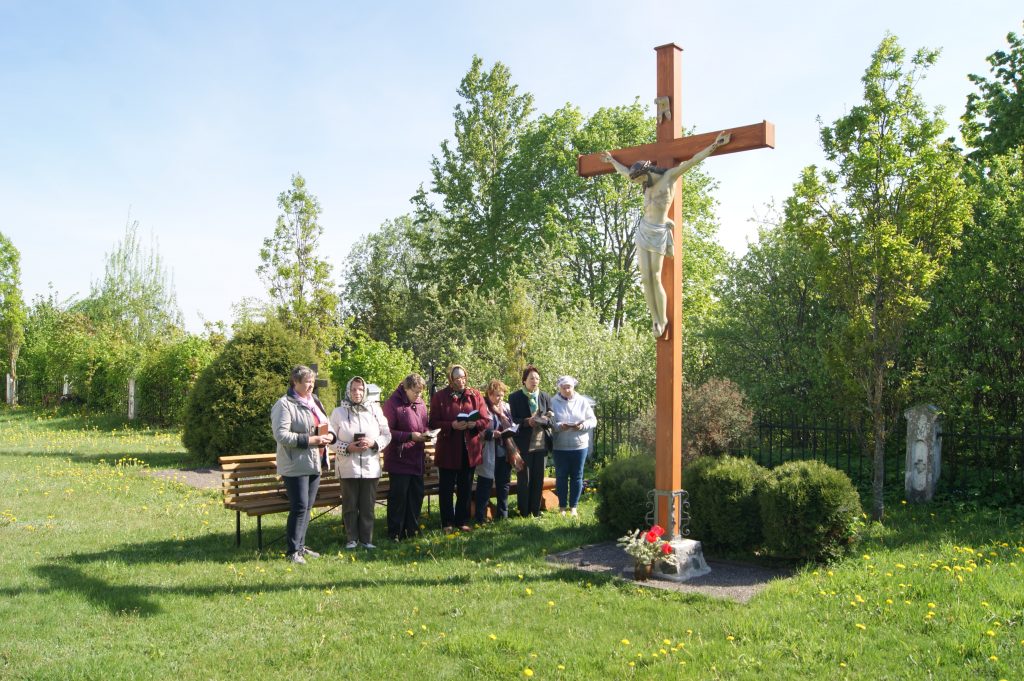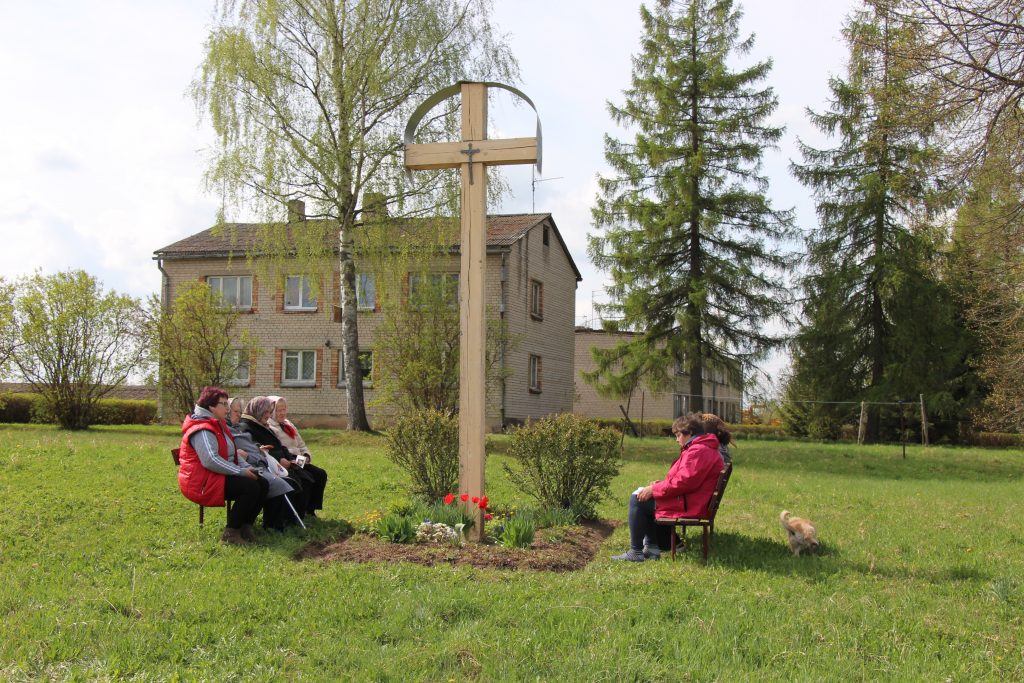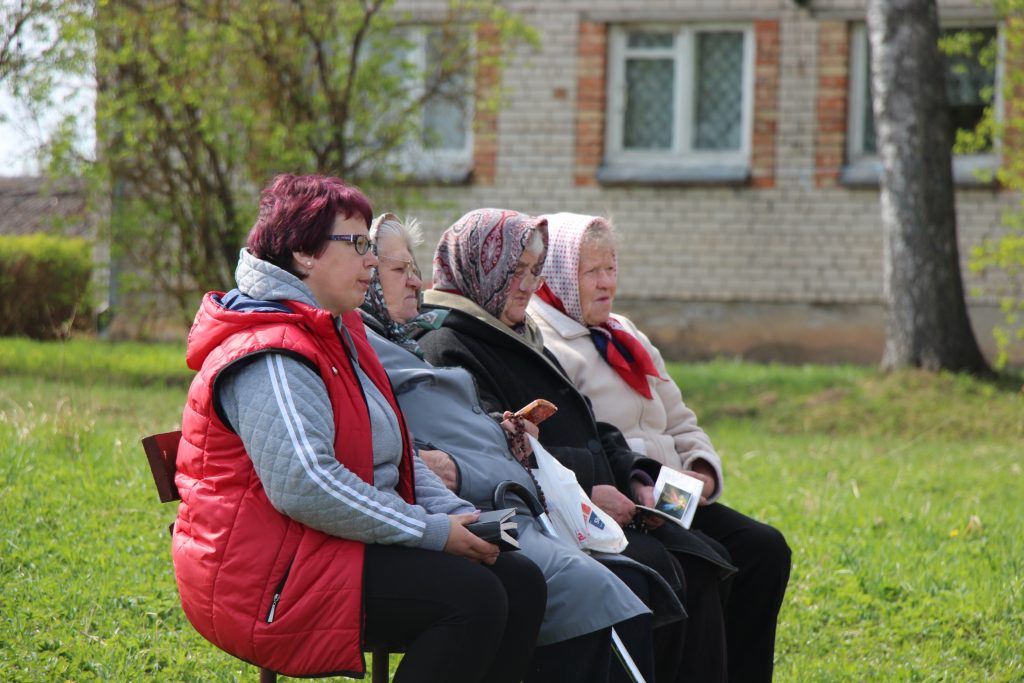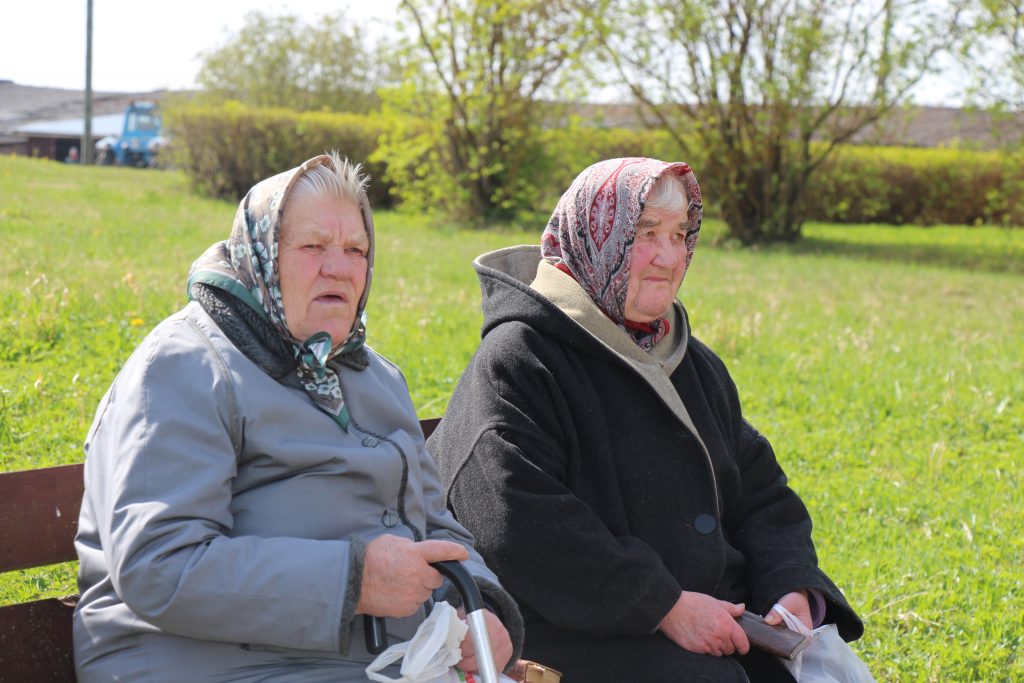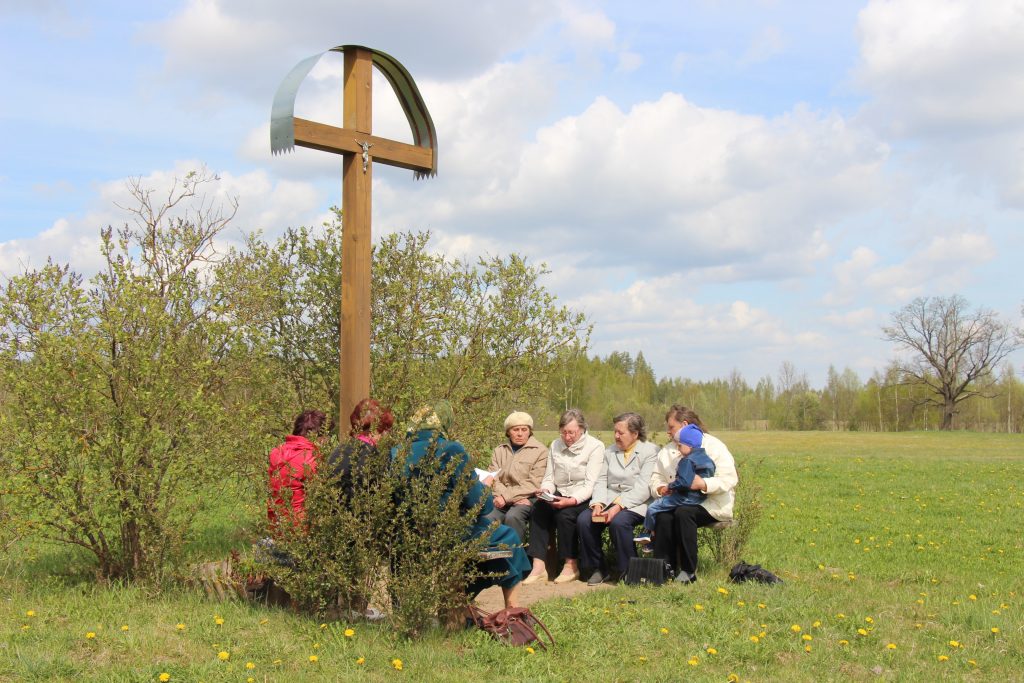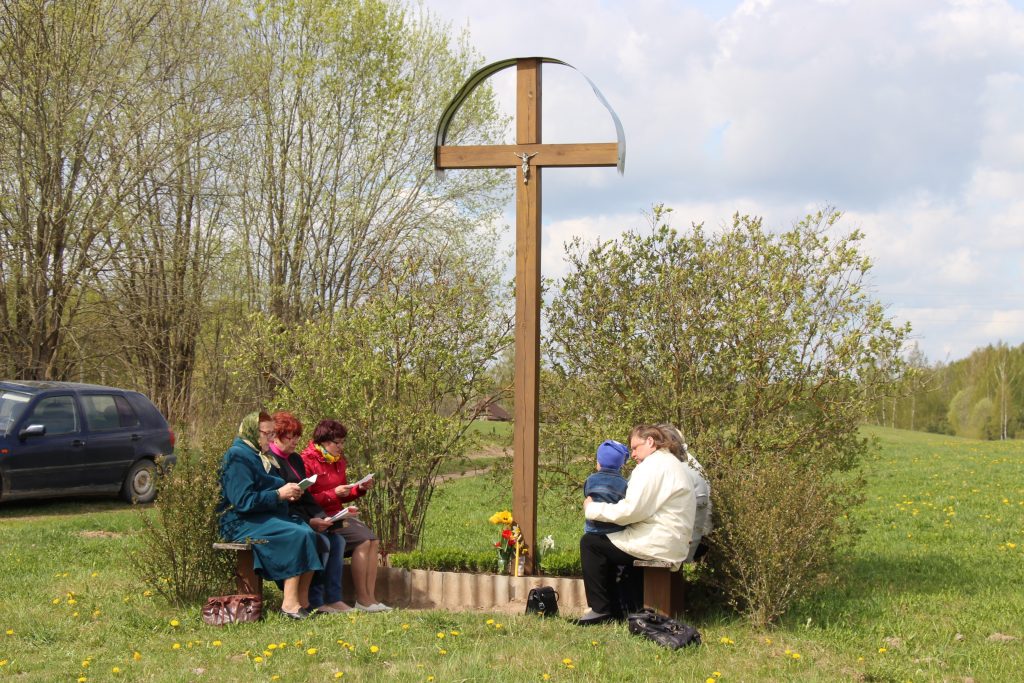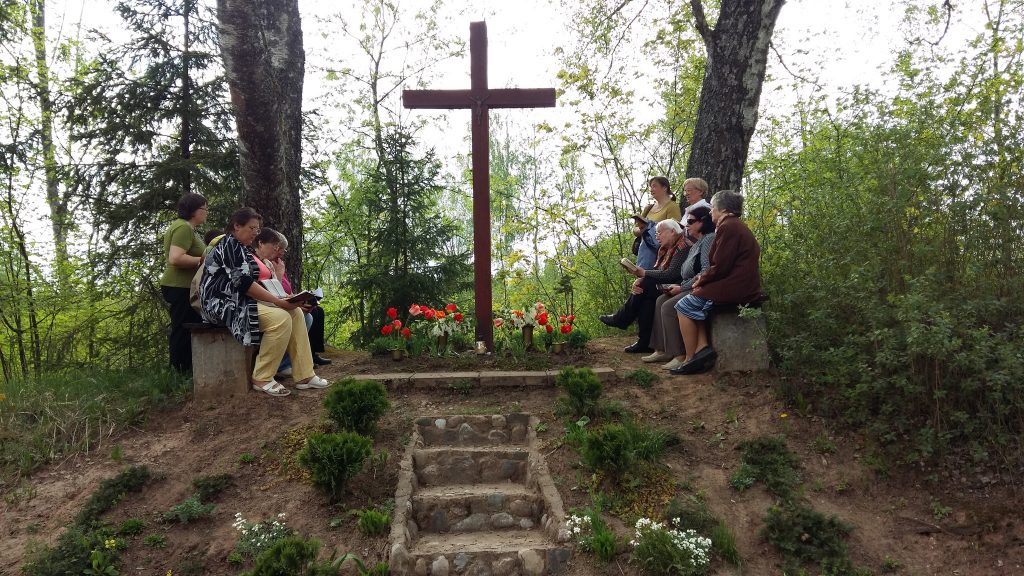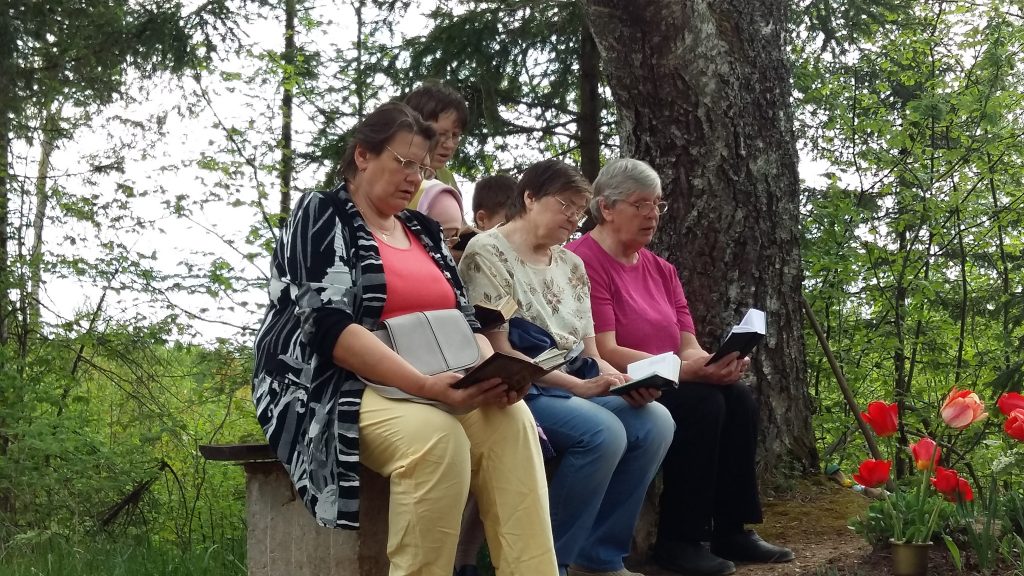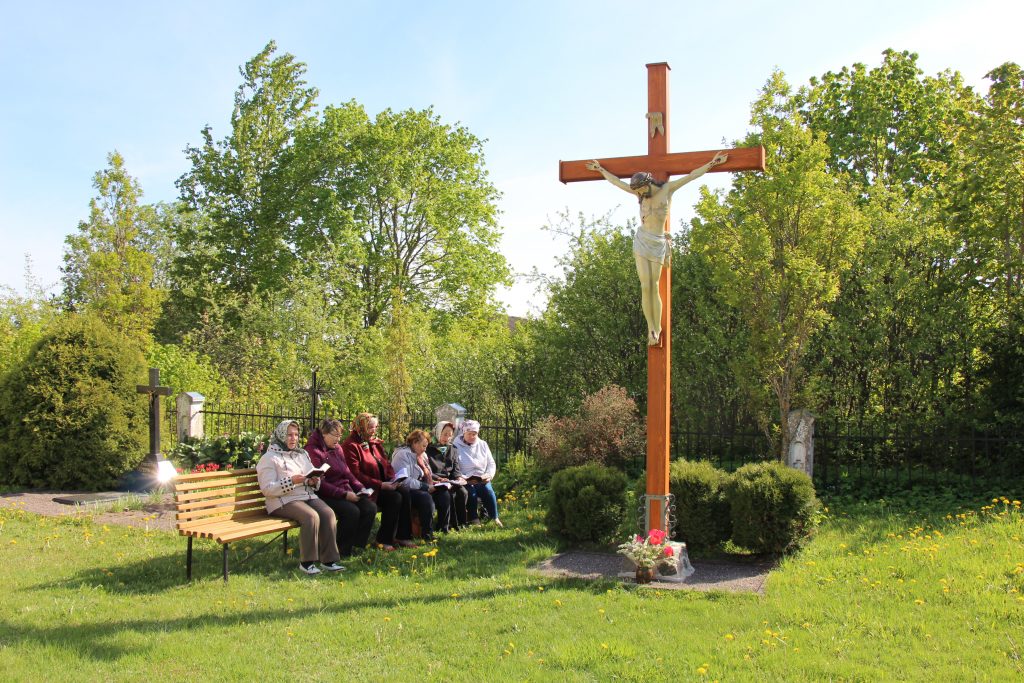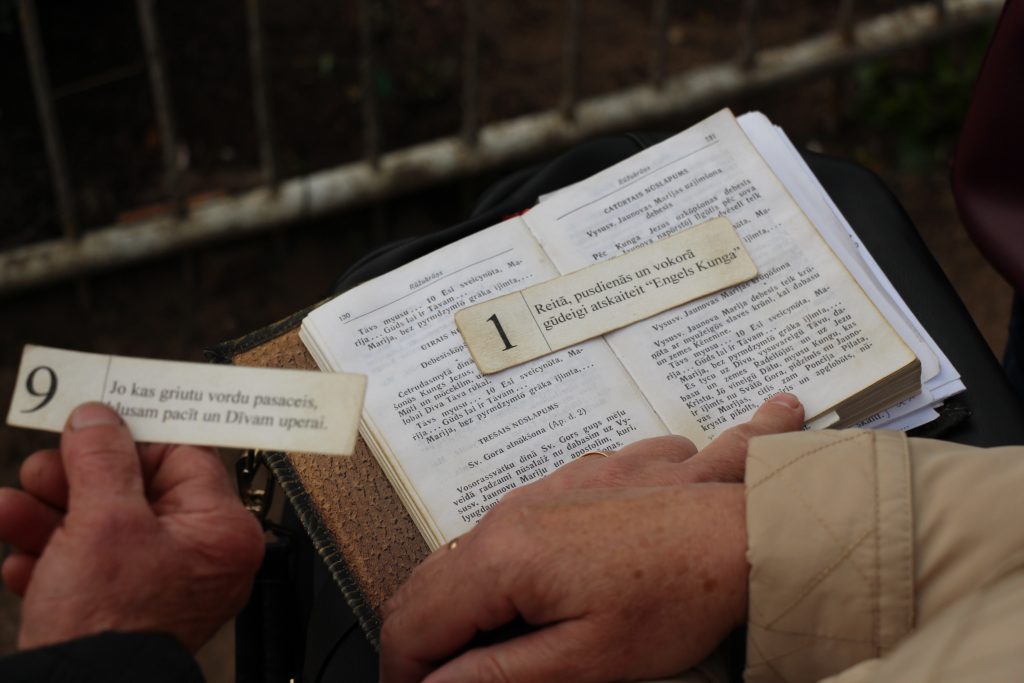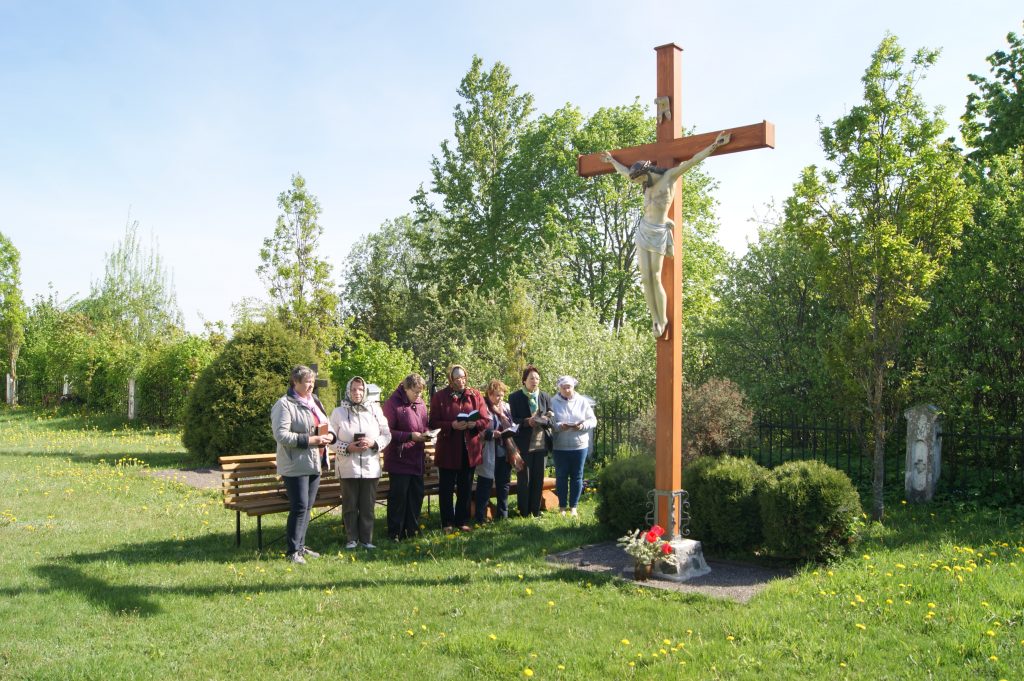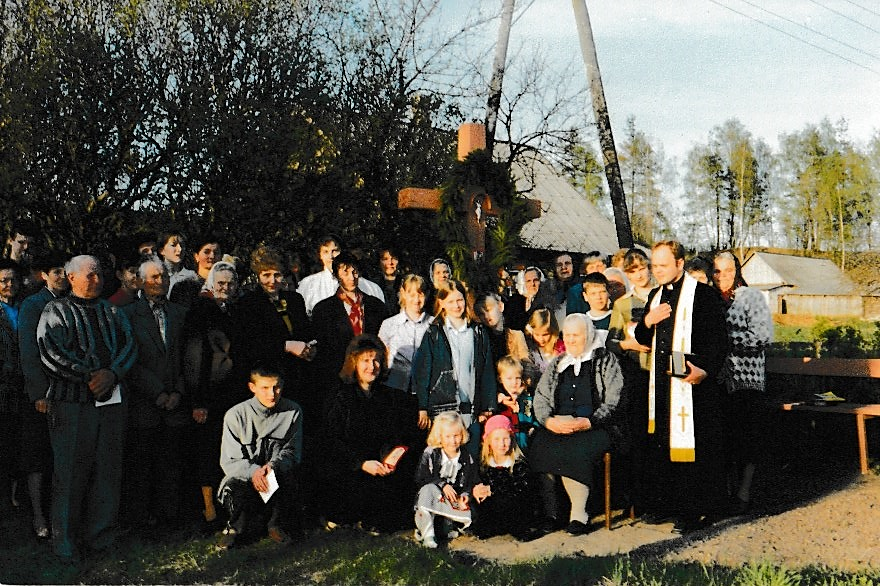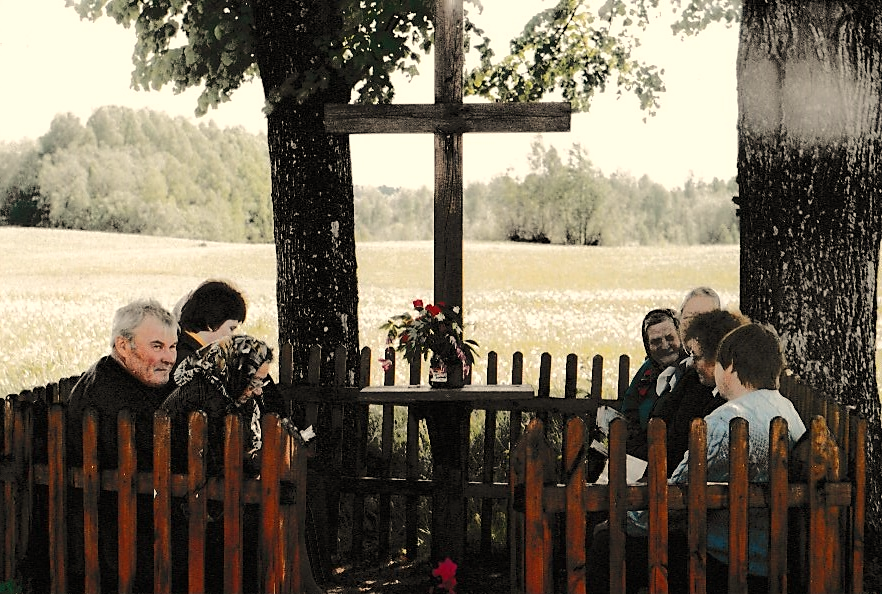Author:
Inta Vilnius
Social practices, rituals and festive events
Title
May Services at Wayside Crosses in the Andrupene and Skaune Parishes of the Dagda Municipality (2019)
Dzīduošona pi krysta, maja dzīduojumi
The May Services at wayside crosses - a ritual (service). The ritual environment is associated with wayside crosses as an integral part of the service; the “znački” draw is unique.
Geography
Dagda (now Kraslava) Municipality: Andrupene Parish and Šķaune Parish.
Several parishes of the Dagda Municipality with wayside crosses are connected by this tradition.
These are open communities in the sense that they engage in the practice of May Services and singing at wayside crosses in different numbers and composition of attendees.
It is possible for people to join the service spontaneously. This tradition is preserved and maintained by those who take care of the areas surrounding wayside crosses, decorate them, gather near them for religious services in May, and considers this tradition to be of great value.
In the Skaune Parish, this community overlaps with the folklore group “Gaiļupeite”, while in Andrupene – it overlaps with the church choir. The Astasova community of the Andrupene Parish is composed of local residents who purchase everything necessary to clean and decorate the area of wayside crosses (a new flower bed installed at the bottom of the cross is not only delightful to the eyes, but draws attention of those passing the area, candles are lit during the service and birch branches are brought to the cross during Pentecost).
In parishes, where May Services at wayside crosses no longer take place, individuals still keep their wayside crosses in order, decorate them (especially in May) and visit them for their own personal prayers.
The parish municipalities are concerned with the cleaning and replacement of old roadside crosses with new ones.
Importance in Community Life
In the Dagda Municipality, the wayside crosses are treated with special respect and care. Elderly people, upon passing a roadside cross, stop, cross their heart, pause for a moment before moving onward.
The area around the wayside cross is always clean, and the crosses, especially in the month of May, are beautifully decorated, whether or not a service is taking place. The cross is gets cleaned by the locals of the area or anyone who lives nearby. Whenever the weather is warm, fresh flowers are placed at the foot of the cross. They are replaced with artificial ornaments when the weather gets cold. The wayside cross is particularly important in areas that are far from the church. It serves as a small church for the people in these places.
Activities/Actions
People gather at wayside crosses as early as April 30th. The service of this day differs in that two types of “značkas” are drawn (a numbered ticket indicating a task that must be executed in a given timeframe) – those in which the task is for the entire month of May, as well as those, in which the task should be carried out until the next day. Believers follow the “značka” with great seriousness, trying to get rid of at least one of their weaknesses, to strengthen their virtues and will.
The May Service is always directly or indirectly managed by one or two leaders. These are people who know and control the entire procedure of the service. It is usually an experienced singer, who decides what songs to sing, starts the song, or instructs other people to do so.
Beliefs, Rituals, Unwritten Rules
The May Service is a strictly structured and complex system. It can be divided into five elements – the songs dedicated to Virgin Mary, the Litany of the Blessed Virgin Mary, drawing of the “značkas”, as well as readings and prayers. There are many variations of songs dedicated to Virgin Mary, that is, the singers choose what to sing at each particular time because there is quite a lot of such songs. These songs are mostly performed in a two-part harmony without special training.
Inheritance and Transfer
The people attending these services in current day are mainly women, there is also a lack of the younger generation.
Most of the singers have inherited the May Service traditions during their childhood. They have gone to sing at the cross together with their family, peers, and neighbors. Since the May Service has been a significant part of their childhood, the desire of these singers to preserve this tradition seems to be self-explanatory.
The age range of the Skaune Parish Muiznieki May Service participants is between 46 and 90. Three of the seven members have inherited the May Service traditions in their childhood, the others have joined to preserve an ancient tradition.
The age range of the Skaune Parish Zamsoviki May Service participants is between 43 and 80. Gertrude Reca says that she is the only one out of an average of ten service attendees, who has visited a wayside cross with her grandmother since childhood, which is why she's the one who conducts the May Service and starts songs.
The age range of the Andrupene Parish Astasova May Service participants is 38-75. The oldest member Zinaida Ostrovska in her childhood and youth participated in May Services at wayside crosses in her hometown, which is next to Astasova.
From April 30 to the end of May, 4-6 attendees participate in Zinaida's most complete enclosed service at the wayside cross, where the “znački” drawing tradition still exists, along with readings from the Bible, which are different for each day. The age range of the Andrupene Parish Andrupene May Service participants is 59-78. Three of the ten members who gather for this service say that they hold this tradition in high regard since childhood. This service is organised not only at the central, but also at other wayside crosses in Andrupene (at the “Andrupenes lauku sēta” museum cross and at the cross mounted on the road behind the Andrupene cemetary) to attract more participants and bring recognition to the tradition.
History
A typical part of the Catholic Latgale landscape is the wayside cross that could once be found in almost every populated area. People gathered at their closest wayside cross on May evenings, thus creating one of Latgale's Catholic cultural phenomena – a joint prayer or song for the Virgin Mary at a wayside cross.
The Latgale Catholic prayers at wayside crosses, which the people called “dzīduošona pi krysta”, “maja dzīduojumi”, are essentially shaped as a peculiar form of the People's Lithurgy, as they were held on their own initiative, without the presence and management of clerics.
The May Services at the wayside crosses were led by people from the community, mostly older wives who knew the structure of the tradition and how to start the melodies at the required pitch.
In the second half of the 19th century and in the 20's and 30's of the 20th century, this ancient and beautiful form of the people's prayer was self-explanatory and widespread among Catholics throughout the entire Latgale region. In May, people gathered around a decorated cross and sang songs until sunset in the evening, recited prayers in honor of the Blessed Virgin Mary. Often in rural areas, a rogue traveler could hear simultaneous singing from several places.
May in the calendar of the Roman Catholic Church is the month dedicated to the Blessed Virgin Mary – a time when special services and prayers are devoted to her.
The May Services at wayside crosses are rituals devoted to the Virgin Mary. The greater focus is placed on the songs devoted to the Blessed Virgin Mary. The learning of the melodies sung at the cross took place mainly in the family during long winter evenings, so the singers knew the melodies of the songs by heart during the May Services. The song texts were taken from the prayer books. The choice and sequence of songs in each particular case was determined by the experience and local traditions of the singers attending the service.
An obligatory component of the service is also the Litany of the Blessed Virgin Mary (The Litany of Loretto; the beginnings of which can be traced back to the 13th century) and the “znački” drawing.
The word “značka” comes from Polish. “Značka” is a numbered rectangular note. The number indicates a task that must be performed in the specified timeframe, for example, “Nasaverīs par vysu dīnu uz tū pusi, kur cīši gribīs vērtīs (Neskaties visu dienu uz to pusi, kur ļoti gribas skatīties [avoid looking at something you really want to look at all day])” vai "Par vysu mēnesi sorgojīs malōšonas un jo gadeisīs samalōt, tod tyuleit atskait vīnu reizi Tāvs myusu (Visu mēnesi sargies no melošanas un, ja gadās samelot, tad tūlīt noskaiti vienu reizi "Tēvs mūsu" [avoid lying the entire month and, if you happen to lie, immediately recite "Our Lord"])".
During the “znački” drawing, the service participants each draw a ticket (the leader of the service holds them in her prayer book).
An essential element of the service is the Bible readings. Each day of May has its own verse or passage. According to each day of the month, from the first to the thirty-first, there are specific and psychologically effective examples and advice on what to do to become a better person. For example, the text on the first day of the month of May contains an implicit indication of the moral meaning of caring for the surroundings of the crucifixes and of sprinkling the image of Mary. Here, the aesthetic function merges with the spiritual: decorating the image of Mary is a gift to her.
During Soviet times, wayside crosses were destroyed, and the May Service traditions were suppressed. They survived only in a few remote places. After the Soviet era, the tradition experienced a strong revival, leaving behind stories of how in Soviet times tractors were ordered to destroy roadside crosses and the sad fate of the tractor drivers who agreed to do it.
People also sing and pray at home, but these prayers are not May services at the cross in the sense they have been used so far. In addition to the local folk tradition, May services are also held in the church. The differences are quite significant: The May Services at the wayside or village crosses were held on the people's initiative – without the presence of a cleric, the church May Services lack the essential elements of a traditional wayside cross service like the “znački” drawing, readings of verses and passages, and, of course, the environment. These are two completely different May Services - the first is an expression of folk traditions and traditional culture, the second, which takes place in the church, is a part of the Church's liturgy.
Nowadays, the tradition of May Services at wayside crosses is experiencing a strong revival in the Dagda Municipality. The confirmation of this is the implementation of the Asune community project "Krucifiksa atjaunošana un teritorijas labiekārtošana Asūnes baznīcas dārzā" ["Renovation of the crucifix and improvements to the Asune church garden”] the manufacture and installation of the crucifix in the territory of the museum “Andrupenes lauku sēta”, despite the fact that the project submitted to the State Culture Capital Foundation was not supported, the old Andrupene central cross was replaced with a new one in 2018.
An honourable mention should also be given to the initiative by the Skaune folklore group "Gaiļupeite", which was formed in 2013 to gather the participants for May services at the wayside crosses in the Skaune Parish, which paved their way to becoming the leaders of this tradition.
Masters
The core of each wayside cross community is made up of elderly women who have participated in May Services at wayside crosses with their parents and grandparents since early childhood.
Juzefa Rucevska (born 1929) takes care of the surrounding area of the Muiznieki wayside cross, and, together with two more elderly women, Olga Rutka (also singing at funerals) and Stanislava Lice, lead the Service and begin songs.
All three of them are the oldest of the Muiznieki wayside cross Service attendees and are known to tell stories of how they used to go to wayside crosses in their early childhood. There used to be 11 of them, but now there are only 3.
Gertrude Reca (born 1938) from the Skaune Parish, Zamsoviki is the oldest member, leads the service, starts songs.
Gertrude recalls that when she was a child with her grandmother, she went to a wayside cross near her home.
Zinaida Ostrovska (born 1943), from Astasova in the Andrupene parish, is the most senior member, conducting services, starting songs, organizing the “znački” drawing, reading from the Bible, conducting singing (also funeral).
Zinaida was also, in her childhood and youth, going to the wayside cross services in her hometown of Bikova (the cross still stands, but the services no longer happen).
In Astasova of the Andrupene Parish, the most complete May Service at a wayside cross was fixed – there is still a tradition of “znački” drawing, reading the Bible, which each day having their own, and the first assembly takes place on April 30. The course of this day's service differs with the fact that two types of “značkas” are drawn, those you need to follow the entire month of May, and those you only need to follow for a day.
Antonina Virza (born 1955) from Andrupene in the Andrupene Parish, is the elder of the Andrupene congregation, takes care of the area around the cross, coordinates the gathering of community members at the cross, leads the church service, starts songs (together with Irina Liepa).
Almost all the members of the Andrupene May Services also sing at funerals and have visited wayside crosses since they were children.
Institutions and Organizations
The Dagda Municipality Folklore Centre – tracks the development of the tradition of May Services at wayside crosses in the Dagda Municipality, provides the necessary information to all interested parties. It is planned to attract the most important tradition masters to workshops to facilitate the exchange of experience, the collection and transfer of traditions.
The Skaune folklore group “Gaļupeite” is taking care of the wayside cross surroundings in their area, organize gatherings at the cross in the month of May, are active maintainers of the tradition of May services at roadside crosses.
The Kraslava Municipality, Dagda City and Parish association, is concerned with the cleaning of wayside crosses, replacing old ones with new ones, and offering financial support. For example, in 2007, just before the start of the May singing at the cross, a wayside cross was installed in the territory of the “Andrupene lauku sēta” museum. In November 2018, a new cross was installed in the centre of Andrupene, a project contest of the Dagda Municipality “Sabiedrība ar dvēseli 2019” [Society with a Soul 2019] supported the implementation of the Asune community project "Krucifiksa atjaunošana un teritorijas labiekārtošana Asūnes baznīcas dārzā" ["Renovation of the crucifix and improvements to the Asune church garden]. The crucifix renovation works were performed by the local carpenter Stanislavs Malkevics.
Strengthening the Tradition
In 2004, Inta Viluma, head of the Dagda Municipality Folklore Centre, carried out a survey of the May Services taking place at wayside crosses across the Dagda Municipality. Several roadside crosses were identified in the Dagda Municipality and surrounding areas (in order to obtain a broader picture of the May Service structure), taking videos and photos the service. The materials are stored in the archives of the Dagda Municipality Folklore Centre.
Continuity/Development
Threats to the Tradition
Threats include a sharp decrease in the population, especially in rural areas, where one by one the villages become empty.
Applicant
Dagda Municipality, Reg. No. 90000041224
Gallery
Audio Materials
Video Materials
Publications
Pantele, G. (2002). The tradition of the May Service in Eastern Latvia. Book: Materials on Culture in Latvia. Riga: Zinātne, 200-214 p.
Miller, Semple (2000) – Eliot Miller, Kenneth R. Semple. The Cult of the Virgin: Catholic Mariology and the Apparitions of Mary. Riga: Lutheran Heritage Fund
Austra Sondore, A. (2010) Maija dziedājumi pie sādžas krusta Preiļu rajona Mozuļos. Personal archive of the author, Case 21
Suplinska, I. (2012). Linguoterritorial Dictionary of Latgale. Rezekne: Rezekne Academy
Websites
https://kulturaskanons.lv/archive/maija-dievkalpojumi/ - Description of the tradition
http://www.katedrale.lv/index.php?id=3439 - Historical aspect of the tradition
http://www.ddmd.lv/index.php/lv/news-2/414-maijs-jaunavas-marijas-godinasanas-laiks - The origin and nature of the May Service
file:///C:/Users/INTA/AppData/Local/Temp/728-2614-1-PB-1.pdf - Description of prayers at wayside crosses in May

